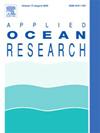Modulus degradation characteristics of saturated marine coral sand under anisotropic consolidation and various loading frequencies
IF 4.3
2区 工程技术
Q1 ENGINEERING, OCEAN
引用次数: 0
Abstract
Marine coral sand is a primary fill material for port and infrastructure construction on coral islands. When embedded in slopes and embankments, it is typically in an anisotropic consolidation and saturated state. A series of undrained cyclic shear tests with various loading frequencies (f) were conducted on saturated coral sand in an anisotropic consolidation state (consolidation stress ratio, kc, and consolidation direction angle, αc). When the 90° jump of loading principal stress path with the cyclic loading direction angle (ασ) of 22.5°is applied, all strain components exhibit significant development, generalized dynamic modulus (K) replaces Young's (E) or shear modulus (G) as the suitable physical index for characterizing the global stiffness. Specimens under anisotropic consolidation persist residual generalized dynamic modulus (Kr) even in the failure phase. Kr increases with increasing kc and f, and decreases negatively exponentially as αc increases. The maximum generalized dynamic modulus (K0) is significantly influenced by anisotropic consolidation state and f. The effect (positive or negative) of the anisotropic consolidation state is determined by αc, and it is nonmonotonic from αc = 0° to 45° The increase of kc only serves to strengthen the effect of αc on K0. Additionally, K0 and f exhibit a strong logarithmic correlation, which is independent of anisotropic consolidation state. Ultimately, relative generalized dynamic modulus (η) is introduced to characterize the decline characteristic of K, and a generalized Davidenkov model which normalized consolidation conditions and f is established over a wide strain range.
求助全文
约1分钟内获得全文
求助全文
来源期刊

Applied Ocean Research
地学-工程:大洋
CiteScore
8.70
自引率
7.00%
发文量
316
审稿时长
59 days
期刊介绍:
The aim of Applied Ocean Research is to encourage the submission of papers that advance the state of knowledge in a range of topics relevant to ocean engineering.
 求助内容:
求助内容: 应助结果提醒方式:
应助结果提醒方式:


